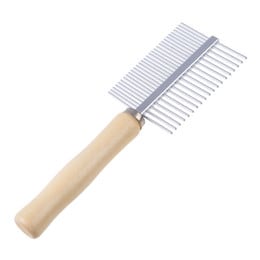 To care for your Schnauzer’s coat, you will need the following grooming tools: your slicker, a double-sided stainless steel comb with both wide and narrow teeth, a small pair of nail cutters, styptic powder, ear cleaner and ear powder. Dematting tools with replaceable blades are a boon in removing mats and tangles, but they must be used very carefully. Have your groomer demonstrate their proper use. It also helps to keep a spray bottle of waterless shampoo on hand for touch-ups between baths.
To care for your Schnauzer’s coat, you will need the following grooming tools: your slicker, a double-sided stainless steel comb with both wide and narrow teeth, a small pair of nail cutters, styptic powder, ear cleaner and ear powder. Dematting tools with replaceable blades are a boon in removing mats and tangles, but they must be used very carefully. Have your groomer demonstrate their proper use. It also helps to keep a spray bottle of waterless shampoo on hand for touch-ups between baths.
To ease into a grooming regimen, begin by stroking your dog’s body, speaking softly and reassuringly as you gently massage him all over. Tickle his belly, pat his head and rub his back. These are the areas where puppies love to be touched. Move on to the feet, playing with his paws, touching his toenails and rubbing the pads to desensitize your dog for future nail trimming before he declares his paws off-limits.
Handle your Schnauzer’s ears, too. Clipping and cleaning them will be a regular part of the grooming routine. Also open his mouth and examine his teeth. This will make your dog less fearful and more cooperative when it is time for vet visits and tooth brushing.
It’s much easier to groom your dog on a raised surface. It’s also kinder to your back. Relatively inexpensive, lightweight and easy to fold and store, a grooming table is a worthwhile investment. You are more in control with your dog on the table that professionals use (with its attached noose and post) but a counter top or workbench can also fill the bill. There should be room for your dog to stand comfortably, but not enough to let him roam around. It helps to have a rubber mat under your Schnauzer’s feet to provide a nonskid surface.
It is a good idea to leave the leash and collar on for these first sessions, to establish your own control and to help train your puppy. Never leave a dog, especially a puppy, unattended on a table or counter top; he must be protected from injury and must also absorb the message that you are in charge.
Pick up your puppy with one hand under his chest, the other under his back end, never squeezing his tummy or lifting him by the scruff of the neck.
Place your Miniature Schnauzer on the table for a few moments each day, practicing his newly mastered sit and stay cues. If your furry friend is too rambunctious, you may need the help of a partner to help him stand still and prevent him from jumping.
